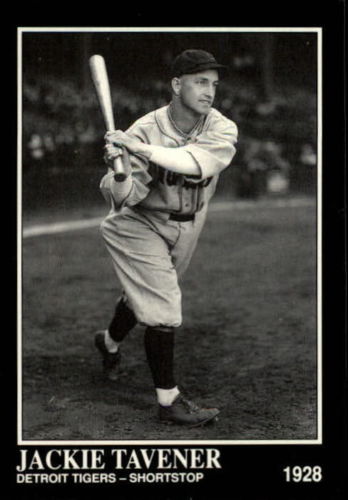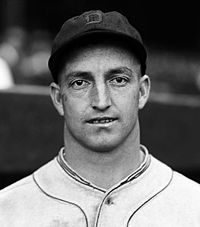Historical Hitter September 12 1924: Jackie Tavener

 Jackie Who? On this day in 1924 Jackie Tavener hit three triples. On September 12, 1925 at the historic and sacred corner of Michigan and Trumbull avenues, he was 3 for 5 with 1 RBI in a marathon 13 inning affair with the Cleveland Indians that was the first game of a doubleheader.
Jackie Who? On this day in 1924 Jackie Tavener hit three triples. On September 12, 1925 at the historic and sacred corner of Michigan and Trumbull avenues, he was 3 for 5 with 1 RBI in a marathon 13 inning affair with the Cleveland Indians that was the first game of a doubleheader.
Retrosheet.org has no play by play, but we know that one of his triples struck in the bottom of the seventh inning tied the game. So we can conclude that the other two triples left Tavener at third or perhaps thrown out at the plate. This game was broken open in the top of the 13th inning when the Tribe pushed across three runs to seal the victory. As was the custom of the day both pitchers went the distance, all 13 innings. The final score was Tigers 1 – Indians 4. Due to the length of the first game the second game was a mere 5 innings which the Tigers won 3-2, Tavener went 1 for 2 with a walk but did not hit any triples in the second game.
Tavener’s story is tragic at two levels. Due to the hard headiness of this manager he was kept back and out of the majors during his the prime years of 24 to 26. And when his career was on the verge of great success he then suffered a small but debilitating injury. There is little still known of him today, there is no SABR Biography on him. In the official Detroit Tigers individual records webpage, the Tigers list Charlie Gehringer, Tavener’s double play mate, as the single game triples leader done on August 5, 1929 with three. Yet the Tigers make no mention of Tavener accomplishing the same feat just a few years earlier.
Tavener was also Hall Fame Goose Goslins teammate in the Columbia Comers of the old Sally league. His speed, range and smarts at shortstop earned Jackie the reputation of being “just about the sweetest fielder in the minors.” When arriving in Columbia, the scout for Clark Griffith, however, signed the bigger Goose rather than undersized Tavener.
At the end of the 1921 season, the Tigers purchased his contract and gave him a tryout. Undersized at 5’-5” tall and only 138 pounds after he tried out with the Tigers in 1921 Ty Cobb, then the Tigers skipper told him directly:
“Kid, you’ve come to us with a reputation of being a smart player and one of the best fielders in the minors, but your size is against you. You just aren’t big enough to make the club.”
Cobb the manager did no favors for Jackie, and kept him in the minors for three years from 1922 to 1924 season in Fort Worth. Tavener removed all doubt that he could play, and help his team win three Texas League pennants, and two Dixie Series Championships 1923 & 1924. After Tavener’s success in the minors, Cobb finally relented.
 While making the club as their full time shortstop in 1925, he was cruelly labeled pee-wee, the Tom Thumb shortstop or The Midget by many in the media. For comparison, Phil Rizzuto the Yankees Hall of Fame shortstop was only 5’- 6” and maybe 150 pounds, while a more famous Pee Wee, Pee Wee Reese was a relative giant at 5’- 10.” But the effect of such mean-spirited and damaging language describing Tavener seemed to spur him on to succeed. Tavener’s career range factor 5.026 is better than either the Scotters (4.788) or the Little Colonel’s of 4.931.
While making the club as their full time shortstop in 1925, he was cruelly labeled pee-wee, the Tom Thumb shortstop or The Midget by many in the media. For comparison, Phil Rizzuto the Yankees Hall of Fame shortstop was only 5’- 6” and maybe 150 pounds, while a more famous Pee Wee, Pee Wee Reese was a relative giant at 5’- 10.” But the effect of such mean-spirited and damaging language describing Tavener seemed to spur him on to succeed. Tavener’s career range factor 5.026 is better than either the Scotters (4.788) or the Little Colonel’s of 4.931.
Nicknamed Rabbit from his base path speed he tied the modern record of three triples in one game, he was one of only four players to steal second, third and home in the same inning more than once- the other three are Hall of Famers Ty Cobb, Honus Wagner and Max Carey. Tavener quickly removed any doubts about his fielding prowess, and his hitting skills improved. Along with second baseman Charlie Gehringer, they became a formidable infield pair. It was after the 1926 season, where Sam Greene of the Sporting News gave high praise as being the best fielding shortstop in the league, and a feared batsman in the pinch. After Cobb was released from his managerial duties for the 1927 season, Tavener came into his own both in the field and at the plate.
Sadly, and tragically, in the middle of the 1927 season, Tavener cut his finger fumbling around in the ice box at home. The resultant injury was devastating. He had lost feeling in his index finger of this throwing hand thus not capable of making the throw from shortstop with power and accuracy. Runners that were typically gunned down before his finger injury were now reaching first safely or by error after the finger injury. While he played in Motown for one more year and rather successfully, he was traded to Cleveland and sadly never regained his form; after just 92 games in ‘29 he was out of the majors. For the record, his illustrated baseball card is worth about a dollar.
Tavener’s career is one that could and should have been better, but negative stereotypes about his size by team management and then injury kept him from reaching his potential. Yet on September 12 we remember him for his baseball success, three triples for the Tigers in one game.
The overall baseball record is 4 triples in one game. Those two events were accomplished in the 19th Century by Bill Joyce on May 18, 1897 for the Giants and George Strief on June 25, 1885 against the Brooklyn Grays the team that eventually become the Dodgers. No major leaguer hit 4 triples in a game in the 20th Century.
